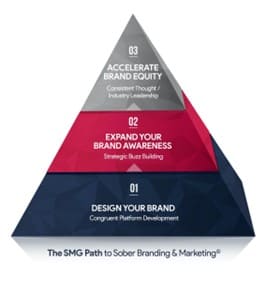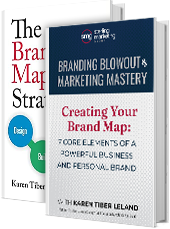Summary:
Karen Leland, an expert in personal branding, highlights the significance of personal branding for CEOs, executives, and entrepreneurs in today’s business landscape. Drawing from over 20 years of experience and work with renowned companies, Leland emphasizes the importance of authenticity and strategic planning in personal branding. She outlines the three stages of personal branding strategies, focusing on platform design, brand awareness expansion, and consistent thought leadership. Leland provides practical insights, such as the Personal Brand Pyramid©, to guide individuals in crafting and amplifying their personal brands effectively. Additionally, she offers resources like a personal branding quiz and encourages seeking expert help for optimal results in personal branding endeavors.
Do customers care if their lawyer, doctor, accountant, or the CEO of their utility company has a public personal brand? It turns out they do. Recent research has found that 74% of American consumers would likely trust someone with a respected personal brand, and 82% of Americans agree that companies are more influential if their leaders have an executive brand they know and follow.
For over 20 years, I have helped CEOs, C-Suite executives, entrepreneurs, and start-up founders create and implement business and personal brands. Much of what I’ve learned about this topic comes from up close and in the fieldwork with leaders from companies such as Apple, Google, LinkedIn, Marriott Hotel Group, Johnson, Johnson, American Express, and many more.
At one point, I had so much information in my head that I just had to get it down on paper. That is how I wrote my twelfth traditionally published book, The Brand Mapping Strategy: Design, Build and Accelerate Your Brand, and gave a TEDx Talk on the unique contribution that underlies each of our personal brands.
As an author and columnist for Inc.com, I constantly search for studies, surveys, real-world examples, and techniques to help my clients achieve stronger brands that make them stand out in the marketplace. In this article, I have aimed to share some of the most important things I have discovered about personal branding. The best place to start is at the beginning.
What Is Personal Branding?
Jeff Bezos famously said, “Your brand is what other people say about you when you are not in the room.” However, authentic personal branding is not a simple elevator pitch strategically placed in a company bio or a social media beauty contest.
It’s an overall approach to executive branding that every Entrepreneur, CEO and C-suite leader is charged with creating in today’s wired world. It’s leveraging the assets that an individual possesses and bringing them to the forefront to create greater awareness and engagement with their unique story. Leaders who fail to create a personal brand do so at their own peril.

Why is Personal Branding Important?
Personal branding impacts all the stakeholders involved with a business, including a company’s customers, employees, potential hires, and investors. For example, research from Brand Builders found that 67% of all Americans would be willing to spend more money on products and services from the companies of founders whose personal brand aligns with their values.
However, building a personal brand doesn’t just have a positive impact on consumers. It also has a profound influence on employees and potential hires. According to the Edelman Trust Barometer, 60% of potential employees will choose a place to work based on their beliefs and values.
As for current employees, 76% of senior executives believe that having a CEO on social media gives the brand more credibility (hootsuite.com, 2022). In addition, Brunswick Group surveyed 3,600 employees of companies and found that employees prefer working for business leaders who are active on social media by a ratio of four to one.
The report also found that executives who are vocal online are seen as more transparent and accessible, a perception crucial for retention and recruitment (financialpost.com, 2022).
Other survey findings included that 82% of employees will research a CEO’s online personal brand when considering joining the company.
Finally, there is ample evidence that personal branding has a distinct impact on investors. One survey from Burson-Marsteller indicated that based on a CEO’s reputation, 95% of those surveyed decided whether or not to invest in a company (forbes.com, 2022).
3 Stages of Personal Branding Strategies.
Over the years, I have worked with thousands of leaders on their executive brands. They all have in common, regardless of their company size or location throughout the world, a desire to build an undeniably effective personal brand.
Yet, many CEOs, executives, and entrepreneurs need to know where or how to start. They often need clarification about which personal brand strategies will most effectively help them achieve their goals.
My answer to this is the Personal Brand Pyramid©. An organic process in three distinct stages, built over an extended period.

Stage One: Design Your Personal Brand.
Before a leader jumps headlong into pushing their brand out into the world, creating a solid platform on which that personal brand rests are essential. The key to forming this foundation includes the following elements:
Brand Sound Bites: These are the deeper ways leaders talk about and represent their personal brand. Beyond the archetypical “elevator pitch,” personal branding requires answering several questions, including:
- What makes your personal brand unique?
- What is your authentic personal brand story or narrative?
- What’s the story behind how you ended up being the leader you are?
- What are the things you offer that are proprietary and unique?
- What is the emotional tone of your brand?
Being able to answer these questions thoroughly, completely, and deeply helps shape the way a leader puts their personal brand out into the world in language and design.
A Narrative Bio. Most bios are written as a list of accomplishments. They are a laundry list of what the leader has done, along with a series of platitudes, usually related to teamwork and vision. The key to personal branding is to write a bio that shows in action, what a leader is about and relates the specifics of their accomplishments. This bio can then be used on their company website, LinkedIn, and other social media sites.
Congruent Online Representation. According to a DataReportal, 2022 survey, 75% of internet users use social media to research brands. Another report in Sciencedirect.com determined that CEO social engagement positively influences CEO authenticity and approachability, which leads to public trust and satisfaction. Having social media sites that are consistent, up-to-date, modern, and on-brand is a significant part of creating a foundation upon which to build a successful personal brand. At this stage in their personal branding journey, leaders’ most significant hurdle is their failure to ask for or engage expert help. Most leaders see the importance (and logic) of creating this foundation but usually don’t have the time or knowledge to execute it. Hiring outside expertise, and implementation assistance can help put the platform in place necessary to attain thought leadership.

Stage Two: Expand Your Personal Brand Awareness.
Once a robust platform for a personal brand has been established, it’s time to accelerate awareness. Unfortunately, the built-in bias around how to go about this is not always a recipe for success.
I call this phenomenon Drunk Marketing©. Shameless plug here. My 13th book, No More Drunk Marketing, will be available in the Spring of 2023. Essentially, Drunk Marketing© is a combination of magical thinking combined with unanchored action.
Here’s the essential issue. There are more than 40 tactics a leader can use to build their personal brand buzz. Almost no one should be spending the time or money to pursue every one of them. All these actions are not created equal.
Depending on various factors, specific tactics will be more highly impactful for an individual’s personal brand than others. In my experience, narrowing the list down to the most important 2-4 tactics for personal branding comes down to answering three questions.
- What’s the return on investment for a particular tactic, given the objectives for your personal brand?
- Does this tactic consider where and how your audience consumes their information?
- Where are your personal brand’s current strengths, weaknesses, opportunities, and threats, and what does this indicate about the best tactics to put in place?
For example, I’ve worked with executives and CEOs where posting high-quality, rich, on-trend, and educational content three times a week on LinkedIn would be one of their best tactical actions to build a personal brand.
However, they wanted to put in less time and effort to make this happen and avoid spending the money to hire a social media content manager to do it for them. Instead, they decided to go after the easy action of having their marketing department post weekly about what the company was doing.
Was this inherently a wrong move? No, but it was a tactic that did not result in raising the thought leadership profile of the CEO or building their personal brand.
Additionally, the CEO was violating the 80/20 rule of social media by mostly posting about what the company was doing. The best results happen when 80% of the content posted on social media is entertaining, educational, or inspirational, and only 20% is promotional or about the company.
A personal brand (or business brand, for that matter) is most effective on social media when it brings something to the audience rather than asking for something from them.
The most prominent mistake CEOs, C-Suite executives, and high-end entrepreneurs make in Stage Two is focusing too much on short-term results and failing to consider the long-term impact of their brand-building tactics.
Stage Three: Create Consistent Thought Leadership.
By building a solid personal brand platform in Stage One, choosing the right tactics, and executing them well in Stage Two, leaders can organically move into Stage Three and accelerate their personal brand equity to a new level.
In my experience, the essence of thought leadership as the end game of personal branding rests on creating a robust content marketing strategy – online and off. Specifically, leaders wanting to establish thought leadership need to:
Form New Thoughts. Thought leaders are constantly researching. They’re doing surveys and polls. They’re countering common thinking and adding something new to their field. They are the ones who point the way to the trends and even invent them. A leader with a personal brand based on thought leadership isn’t just repeating what others have said but is acting as a portal of expertise in their chosen field.
Speak For Their Industry. Thought leaders speak at conferences, moderate, and participate in panels, host webinars, and are expert guests on other webinars and podcasts. You see them on TV or hear them on the radio and read their quote in articles. Leaders who have achieved thought leadership with their personal brand are a go-to source for the media in their industry or field.
Generate High-Quality Content. Lots of it. Thought leaders have a personal brand centered around being content producers. They write books, pen blogs, and whitepapers and regularly post useful (not promotional) content on social media. Thought leaders create videocasts and podcasts. They are known in their industries and the general business community at large as a reliable source of expert information, informed opinion, and original ideas.
The biggest mistake leaders make in Stage Three is overpromoting themselves before they have the goods to back it up. In other words, they have put the tactical horse before the strategic cart.
For example: I am regularly contacted by CEOs and C-suite executives who tell me they want to build their thought leadership by starting with a PR campaign. It is often my unenviable task to point out that this approach does not always guarantee the personal branding outcomes they are looking for.
Why? For the simple reason that PR and media placement is a tactic, not a strategy. And while I am a wholehearted fan of getting my clients media, and I have procured hundreds of top placements for clients over the years, they need to be in a place where the PR will take.
The simple truth is that PR has only a minimal chance of success if the foundation and core brand-building activities are not in place first.
For more ideas on how you can strengthen your personal brand check out my article on Entreprenuer.com
Essentials for Personal Branding.
Regardless of which stage a leader finds themselves in, certain essentials are required for any CEO, executive, or entrepreneur looking to build an effective executive brand. Think of these are as the teeth brushing of personal branding. They include:
A Robust LinkedIn Profile. A solid LinkedIn profile includes a proper headshot, a narrative about section (with a focus on showing who you are, not telling), an expanded headline section that makes use of keywords, and a fully filled-out profile that includes projects, positions, awards, contact information, and relevant links.
Consistent Social Media Content. Posting at least 3x a week with 80% high-value content (including images and video) and no more than 20% promotional or company-centric posts, is a best practice that builds audience and reputation.
A Brand at a Glance© Cheat Sheet. A highly designed single sheet that can be sent as a PDF to media, conference producers, investors, and anyone else that once a quick understanding of the leader’s personal brand.
A Personal Branding Strategic Plan. In the same way, a leader would create a strategic plan for their business; an overall strategy is required to develop a personal brand. Some of the core questions to ask yourself when creating a personal brand strategy include the following:
- What will you do to enhance your online reputation in the coming year?
- What direction will your thought leadership take in the coming year?
- What is your content strategy for getting your personal branding message across in the coming year?
For a deeper dive into these questions, check out my article on Inc.com.
Examples Of Good Personal Branding.
Recent research shows that 86% of consumers say authenticity is important when deciding what brands, they like and support, yet more than half (57%) of consumers think that less than half of brands create content that resonates as authentic (socialmediatoday.com, 2022). So, what does good personal branding look like?
While there is no one answer to this question, here are a few examples from some of my CEO and entrepreneur clients, who, while they may not be famous, are doing a solid job of establishing their personal brands. Check them out here.
- LinkedIn Profile: https://www.linkedin.com/in/carolina-sasson-938b782/
- Social Media: https://www.linkedin.com/in/chrisrichardsonrealestate/recent-activity/
- PR Placement: https://truecodecapital.com/media-inquiries/
- CEO Personal Brand Website: https://kenlagrande.com
- Book Authorship: http://www.powerofyoga.com/featheredpipe_zoomclass/index.shtml

Where Do You Stand with Your Personal Brand? Take The Online Quiz.
If this article has convinced you of anything, it has left you with the undeniable reality that in a post-pandemic world, having a personal brand is a requirement, not an option for CEOs, C-Suite executives, and high-end entrepreneurs. Which begs the question, where do you stand with your personal brand? Take this simple nine-question quiz to find out.
This Personal Brand Quiz will help you quickly determine what stage your personal (or business) brand is at and specific suggestions for moving it to the next level. Fill out the quiz on my website, and when finished, you will receive an email with your score, current stage, and recommended next steps. In addition, you can sign up for an initial personal brand consultation with me at no charge at karen@karenleland.com
Next Steps: What Is Your Personal Branding Plan?
For CEOs, executives, and high-end entrepreneurs who want to get their messages across powerfully, motivate others to action, and be authentic, personal branding is a must. The only question is, how will you build yours? A simple way to think about your next steps is to start the way I do with my clients. A good, old-fashioned SWOT analysis on your executive brand. Ask yourself:
Strengths. What are the current strengths of your personal brand? What is working about how you are successfully putting your brand out in the world?
Weaknesses. What are the current weaknesses of your personal brand? Where are you missing the mark in creating a personal brand in your industry or the business environment at large?
Opportunities. What are the current opportunities for your personal brand? What are your competitors doing that you should be involved in? Where are you leaving opportunities on the table to get your personal brand out in the world?
Threats. What are the current threats your personal brand is facing? The threats to your personal brand don’t have to be huge. Sometimes threats are other competitors establishing their thought leadership, sloppy online representation of your personal brand, or simply not having an organized strategy to build an executive brand.
Once you have done a sober SWOT, the next step is to take the results and assess three levels of action.
- The first is the “Low Hanging Fruit.” What are the easy, low-cost actions you can take that will bolster your strengths and opportunities and/or diminish your weaknesses and threats? These are often actions that will give you an immediate result. For example, putting up a new photo on your LinkedIn profile, writing a month’s worth of high-value social media posts, or saying “yes” to an industry podcast you have been asked to be on.
- The second level is “simmer” actions. These items keep your personal brand moving forward at a steady, albeit slow, pace. They include actions addressing weaknesses and threats that low handing fruit items have not fixed. For example, creating new content to drive older or less positive content down in Google results, doing a small outreach to relevant podcasts to be a guest, and creating a small, limited PR campaign to local media.
- The third level of action is “Scale the Mountain” items. These are the big rocks of building your personal brand. They are the items that often take a lot of time and money. They can include creating a CEO website, writing a book, or putting a full nationwide PR and media campaign in place.
One word of caution, you can’t see the inside of your own eyelids, so consider getting some outside help to conduct a SWOT on your personal brand. In addition, if you lack the time, talent, or in-house ability to implement these items, an outside firm can be worth the money. To learn more about the five types of executive branding services that might be right for you, and the benefits of each, check out my article at Inc.com.
With strategy in hand, and your implementation plan set, you are ready to begin your personal branding journey. A journey that can lead not only to an increase in brand equity, deal flow, and thought leadership – but the satisfaction of knowing that you are making your mark and contributing your unique talents to the world around you.
Could You Use Some Help with Your Personal Branding?
As you read this article, if you think, “yes, I get it, I need to do this,” but are in a quandary about how to get there, consider booking an initial consultation with me at no charge.
I will review your online brand before our call and give you at least one or two specific ideas you can use to build a better personal brand. No sales, just useful information and insight.
You can book a session with me here.
